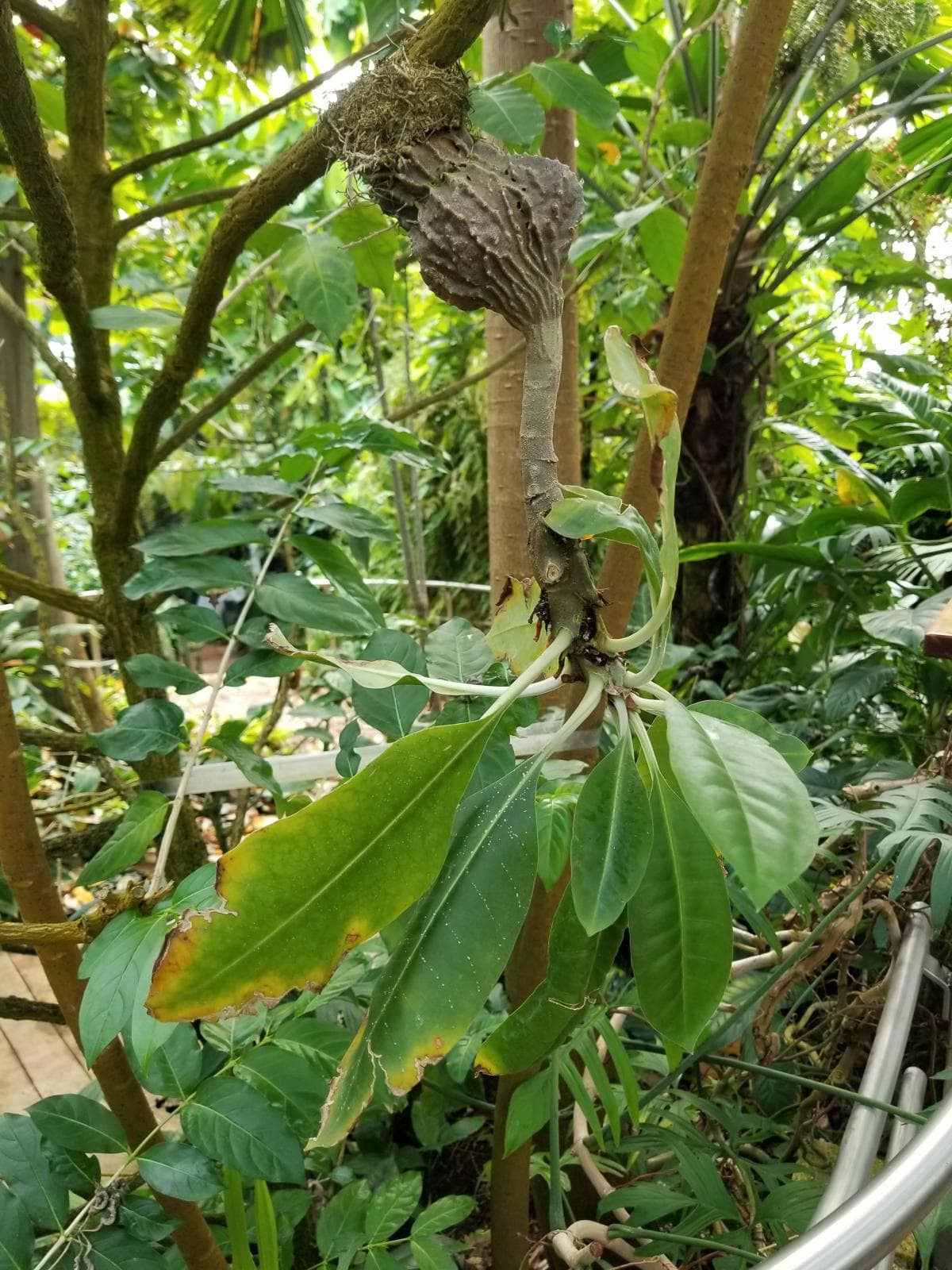Myrmecodia tuberosa
Let’s explore a plant growing in the conservatory. This plant has a mutualistic relationship with ants! This means the plant and the ants both benefit from their relationship. This plant’s scientific name is Myrmecodia tuberosa. This plant’s common name is Ant’s Plant. Look closely at the photos and videos below. What do you notice? How do you think this plant has adapted to survive in its environment?

Scientific Name: Myrmecodia tuberosa (mur-meh-KOH-dee-uh too-bur-OH-suh)
Family: Coffee Family (Rubiaceae)
Common Name: Ant’s Plant
Range: Southeast Asia
Myrmecodia tuberosa
Myrmecodia tuberosa

Epiphyte. Most roots grow underground, but not all roots! Epiphytes are plants that grow entirely above ground! Their roots do not anchor the plant to the ground. Instead, they anchor the plant to another plant! These roots can absorb nutrients and water from the air and from other plants. Wet environments have nutrient-poor soil, so it can be hard for plants to get the nutrients they need from the ground. Epiphytism is an adaptation that helps the plant survive in environments with limited nutrients available in the soil.
Drip Tips and Vertical Leaves. Drip tips are pointed tips on the ends of leaves. Vertical leaves point toward the ground. In wet environments, it rains a lot. Water is heavy! If water piles up on a leaf, it can break the leaf! Drip tips and vertical leaves are adaptations that help the plant survive in environments with heavy rain.
Caudex. The stem is wide and swollen. This is called a caudex! In this Myrmecodia, the caudex does two things: 1) The caudex stores sugars and nutrients for the plant, and 2) the caudex provides a home for the plant’s ants!
Watch this video to see ants on an Ant Plant!
Questions & Prompts
What do you observe?
What do you wonder?
Imagine touching this plant. What would it feel like? Do you think different parts of the plant feel different?
If you could ask this plant one question, what would you ask?
This plant’s common name (or nickname) is Ant’s Plant. Why do you think people chose this common name? What common name (or nickname) would you give to this plant? Why?
What do you think would happen to this plant if it were transplanted to a desert? Why do you think that?
Creative Prompts
What colors do you see on this plant? Do you see any of these greens? Can you recreate these colors using art supplies?
What do you think this plant’s stem looks like on the inside? Create an artwork or write a descriptive paragraph.
Be an engineer! Study the adaptations that help this plant survive in a nutrient-poor environment. Create an invention to help people survive nutrient-poor environments. Your invention should use the same features this plant uses. What does your invention do? Is your invention sustainable?
Be an artist! Create an abstract artwork based on this plant’s features. When you’re done, write a label for your artwork.
Be an artist! Create a pattern artwork based on a plant part pattern you see. When you’re done, write a label for your artwork.
Be an artist! Create a work of botanical art for this plant.
Write from the perspective one of the ants living in this Ant’s Plant. What do they think? What do they notice? What do they do?
Resources and References
Huntington Database Entry https://huntingtonbg.maps.arcgis.com/apps/instant/attachmentviewer/index.html?appid=5c77c325bab7412ca95c9187d430491c¢er=-118.1144%2C34.1288&level=14&defaultObjectId=108&attachmentIndex=0&selectedLayerId=Plant_Database_7848
Brads Greenhouse & Gardening. 2016. https://www.youtube.com/watch?v=kbyGI8PGPjI&ab_channel=BradsGreenhouse%26Gardening.
“Myrmecodia Tuberosa Jack.” n.d. Accessed June 7, 2021. https://www.gbif.org/species/2902953.
“Myrmecodia Tuberosa Jack.” n.d. Plants of the World Online. Accessed June 7, 2021. http://powo.science.kew.org/taxon/urn:lsid:ipni.org:names:757002-1.




